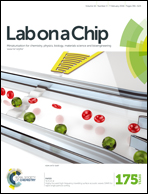An inverted dielectrophoretic device for analysis of attached single cell mechanics
Abstract
Dielectrophoresis (DEP), the force induced on a polarizable body by a non-uniform electric field, has been widely used to manipulate single cells in suspension and analyze their stiffness. However, most cell types do not naturally exist in suspension but instead require attachment to the tissue extracellular matrix in vivo. Cells alter their cytoskeletal structure when they attach to a substrate, which impacts cell stiffness. It is therefore critical to be able to measure mechanical properties of cells attached to a substrate. We present a novel inverted quadrupole dielectrophoretic device capable of measuring changes in the mechanics of single cells attached to a micropatterned polyacrylamide gel. The device is positioned over a cell of defined size, a directed DEP pushing force is applied, and cell centroid displacement is dynamically measured by optical microscopy. Using this device, single endothelial cells showed greater centroid displacement in response to applied DEP pushing force following actin cytoskeleton disruption by cytochalasin D. In addition, transformed mammary epithelial cell (MCF10A-NeuT) showed greater centroid displacement in response to applied DEP pushing force compared to untransformed cells (MCF10A). DEP device measurements were confirmed by showing that the cells with greater centroid displacement also had a lower elastic modulus by atomic force microscopy. The current study demonstrates that an inverted DEP device can determine changes in single attached cell mechanics on varied substrates.


 Please wait while we load your content...
Please wait while we load your content...